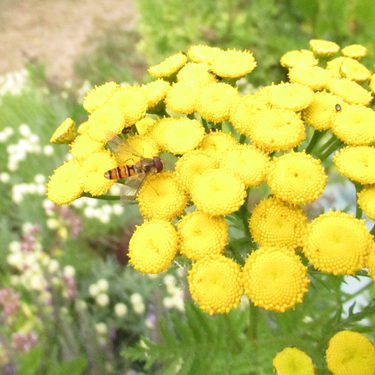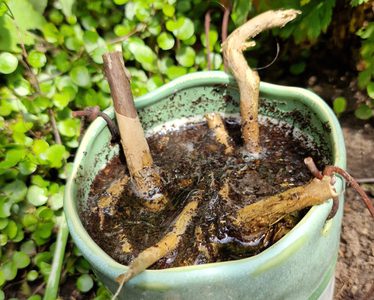
Create your own hoverfly habitats
Of all the beneficial pollinators in our gardens - hoverflies are one of the most overlooked. And yet they play a vital role in 'pollination services'. They also help recycle organic matter, and their larvae mop up 'pest' insects such as aphids.
What are hoverflies?
Hoverflies are true flies (with two wings), from the family Syrphidae, and there are more than 280 species in the UK. They can often be brightly coloured to mimic bees and wasps - but they do not sting.
Where would I spot a hoverfly?
On a warm day, you'll find hoverflies darting and hovering around your garden or allotment as they look for food sources or take part in territorial displays.
Many flat-topped flowers will attract hoverflies, such as Japanese anemone, Coreopsis and Calendula - and they particularly like herb flowers such as coriander, fennel and marjoram.
Make a hoverfly habitat
Some hoverflies lay eggs on the underside of leaves, while other like to lay eggs in pools of water or 'rot holes' in trees. The larvae breathe through snorkel-like breathing tubes and eat microbes in the water before hatching into adults after four weeks. Provide a variety of habitats, such as these below, to support them.
1. Create a hoverfly lagoon
Some species of hoverfly like to lay eggs in stagnant water, which is rich in organic matter. Use a pot without drainage holes – you could get children to decorate it - and half fill with water. Add dead leaves and some garden soil. Place a few twigs inside, with the ends sticking out so the hoverfly larvae can climb out. Sink into the ground near your plants.

2. Make a rot hole
These provide a micro habitat for a wide range of insects. Occurring naturally in nature in the boughs of snapped tree branches or decaying wood, they’re home to millipedes, centipedes, earwigs and many more small life forms, and a food source for birds. Hoverflies will also lay eggs in the shallow water or mud caught in these cavities.
But you can also make your own. Take your time to find a decent piece of wood. It needs to be concave and at least 10cm in depth and width. Once you’ve spotted one with a rot hole, cut out the hole for use in your own garden (always get permission from the landowner first). You can also create your own from a piece of thick timber, the older the better. Carve the hole with a saw or chisel and aim to make it look as natural as possible. Rot holes are best placed next to a bog garden or pond, surrounded by planting.
3. Build a bog
Bog gardens offer a moist environment for hoverflies to breed. Planted with open-flowered plants, such as marsh marigold, they also provide valuable food sources.
A bog garden can be created in a large container or a square metre of open ground, in full sun or dappled shade. If you’re building it in open ground, dig out the soil to about 30 centimetres deep and put the soil to one side. Add a layer of sand, a couple of centimetres thick, to the base of your hole.
Over this, place butyl liner or a sheet of plastic and puncture holes in it. Back fill with soil. Add rocks, stones and plants such as marsh marigolds (Caltha palustris), water forget-me-nots (Myosotis scorpiodes), umbrella plant (Darmera peltate), Astilbe sp. and Ligularia sp. These will give shelter to insect life, which in turn will provide food to amphibians.